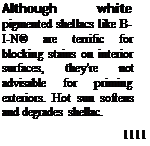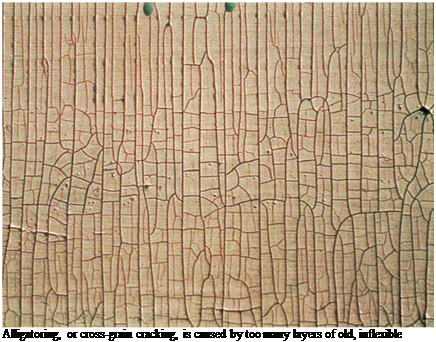Staining and Sealing: A Sampler
There should be a Ph. D. in stains. There are all-pigment stains that won’t fade (a good choice for window trim), water – and oil-based stains, liquid stains, penetrating stains that both stain and seal, and gel stains that won’t run on vertical surfaces. Plus, there are wood conditioners, sanding sealers, presealers, and a plethora of putties and wood fillers. If you want to learn more, excellent resources are Michael Dresdner’s Painting and Finishing and Finishes and Finishing Techniques (both The Taunton Press).
► To achieve an even stain on softwoods such as fir, preseal them with a thinned coat of whatever the clear finish will be, say, 1 part oil-based polyurethane to 4 parts mineral spirits. Presealer soaks into the softer parts of the wood and seals them slightly. But once dry, the surface should still feel like wood.
► Oil-based polyurethane over water-based stains is okay, but do not use water – based polyurethane over oil-based stains. The polyurethane won’t stick.



PROTIP
If you’re using water-based finishes, use damp rags to wipe dust off surfaces, rather than tack rags. Because tack rags are typically a piece of cheesecloth treated with varnish to make it sticky, tack rags leave a faint, oily film that water-based coatings may have trouble adhering to. Tack rags are fine, however, if followed by oil – or solvent-based finishes.
1111
After stripping with hand scrapers and a heat gun, if you decide that your old trim is too beat up or too plain to look good under a clear finish, don’t bother with chemicals. Sand down the remaining paint edges, prime the trim, paint it, and call it a day. It’ll look great.
 1111
1111
drain into the can, allowing the lid to seat tightly into the recess. If the finish skins over, strain the finish or discard it.
Polyurethanes are favored for wood in kitchens, bathrooms, hallways, and other busy areas. Once cured, they’re tough and water resistant. And they’re easy to apply. Oil-based and water-based polyurethanes are equally durable but require slightly different application methods. For both types, apply at least two coats, preferably three.
► Water-based polyurethanes: Because water-based polyurethanes dry clear, use them if you want light-colored wood to stay light. Seal woodwork before application. Thereafter, brush on full strength. Although water-based poly dries quickly, tempting you to apply two coats in a day, wait a full day between coats so it can harden. There’s no need to sand between coats unless a week passes, in which case, use a fine nylon abrasive pad. If you want to add a wax finish, wait a month after application, mindful of the several-week curing time.
► Oil-based polyurethanes: Oil-based polyurethanes impart a rich, amber color to wood. So use them if you favor dark wood or an historic look. They don’t need a preliminary sealer coat, but they will flow on better if you thin each coat with 10 percent mineral spirits.
Oil-based polyurethanes dry slowly, so apply only one coat per day, unless the manufacturer recommends otherwise. Here again, sanding between coats is not imperative unless you wait a week between coats—or you need to sand down imperfections. Before waxing an oil-based poly, be sure to wait a week after the last coat dries.
Shellac doesn’t have the water-resistance of polyurethane, but it dries fast; has a wonderful old-fashioned sheen; and, as noted earlier, adheres well to earlier shellac coats and can be touched up repeatedly. If wood is new or recently stripped, apply a sealer coat of thinned-down shellac: If you’ll be staining the wood, brush on a
1 part shellac to 4 parts denatured alcohol sealer first, allowing it to dry. Otherwise, brush or wipe on a coat of 1 part shellac to 2 parts alcohol, wiping off the excess and allowing the coat to dry
2 hours before sanding lightly with 320-grit sandpaper. Thereafter, apply two or three shellac coatings, thinned with 10 percent denatured alcohol. If the surface is smooth, there’s no need to sand between coats. Wait 1 day between coats and
3 days before waxing. Because shellac dries so quickly, don’t attempt to rebrush it.
Oil finishes include boiled linseed oil, tung oil, and the so-called Danish oils like Watco. Using a nylon pad or a rag, rub a generous amount of oil


onto the wood. Let that soak in for 10 minutes or 15 minutes before rubbing off the excess with a clean, dry cloth. With each coat, the wood will darken slightly. Allow each coat to dry 24 hours and reapply the oil till you get the look you like; usually, two or three coats do the trick. Oil finishes offer the least protection but are easiest to reapply.






Leave a reply